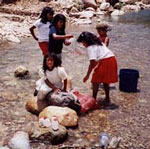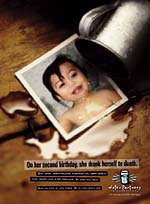Susan Davis is the director of outreach for WaterPartners International, a nonprofit organization that addresses the water supply and sanitation needs of people living in developing countries.

Susan Davis is the director of outreach for WaterPartners International, a nonprofit organization that addresses the water supply and sanitation needs of people living in developing countries.
Monday, 5 Feb 2001
NEW YORK, N.Y.
Today, like every day, more than 25,000 people die because of unsafe water. In developing countries, more than a billion people lack access to safe drinking water. The world’s number one killer is unsafe water. This killer is responsible for 80 percent of all sickness in the world. Drinking from and bathing in polluted water supplies are among the most common routes for the spread of infectious disease, and nearly half of the world’s population suffers from water-related diseases. These diseases are the single largest killers of infants in developing countries — diarrhea alone causes 4 million deaths each year — and access to safe water is directly linked to the survival of children under age five.
So today, like every day since my involvement with WaterPartners, I try to do something to make a difference.

Girls in Honduras collecting water from a stream also used by cattle.
Photo: Gary White.
The groundwork for WaterPartners International was laid in 1990, when our executive director and cofounder, Gary White, and his family invited friends to a dinner to learn about the plight of people in Central America. That first dinner raised $3,000 for a water project in El Limon, Honduras. That water system is still working, as are all the projects we have funded. Gary met Marla Smith-Nilson, our other cofounder and director of international programs, while in graduate school at the University of North Carolina. They officially established WaterPartners as a nonprofit in 1993, with a vision of the day when everyone in the world can take a safe drink of water.
Today starts with getting online. I work for a virtual organization, which means all staff members work out of home offices. Most of our daily interactions are through email. Our “global headquarters” is in Columbia, Mo., where Gary White lives. Marla Smith-Nilson lives in Seattle, Wash. Our director of finance, Dave Sarr, lives in Washington, D.C.; the director of donor services, Erin Keys, also lives in Columbia; the workplace giving coordinator, Steve Hanson, in Portland, Ore.; and the webmaster, Tracy Jackson, in Raleigh, N.C. Some of the newer staff haven’t met all the others, which is why we are looking forward to our staff retreat starting 1 Mar.
I check our web statistics each morning. As the director of outreach, I am responsible for our website content. We significantly renovated our site twice in the year 2000, and I’ve become almost obsessed with the statistics. In addition to the number of visitors, page views, hits, and bytes transferred, you can find out things like length of stay (how long each visitor spends looking around the site) and depth of stay (how many pages each visitor looks at). I keep track of this information to help us measure the impact of our outreach efforts and to influence future content and structure.

Our new ad. Click here for a larger version.![]()
In December 2000, we were thrilled by the donation of space by Fortune magazine for our first national ad. Sullivan Higdon & Sink, a marketing and public relations firm in Kansas City, designed the ad for us pro bono and used their connections to get the ad placed. I have been actively searching for contacts to get the ad placed in other magazines. I even networked on my recent vacation, and today I sent a file with the ad to a friend of a friend who works for an architectural magazine.
My big task for the day is to log more of the video footage from our trip to Honduras. (This is when I wish that I had learned Spanish.) Logging the footage can be a tedious process: We have 11 hours of interviews, scenery, and daily life that I have to wade through and narrow down to five to seven minutes. I’m new to video production, but I’m lucky to have found a professional who doesn’t mind giving me advice.
The website, national ad campaigns, and a video brochure: These are some of the ways that I can help to reach the day when everyone in the world can take a safe drink of water.

